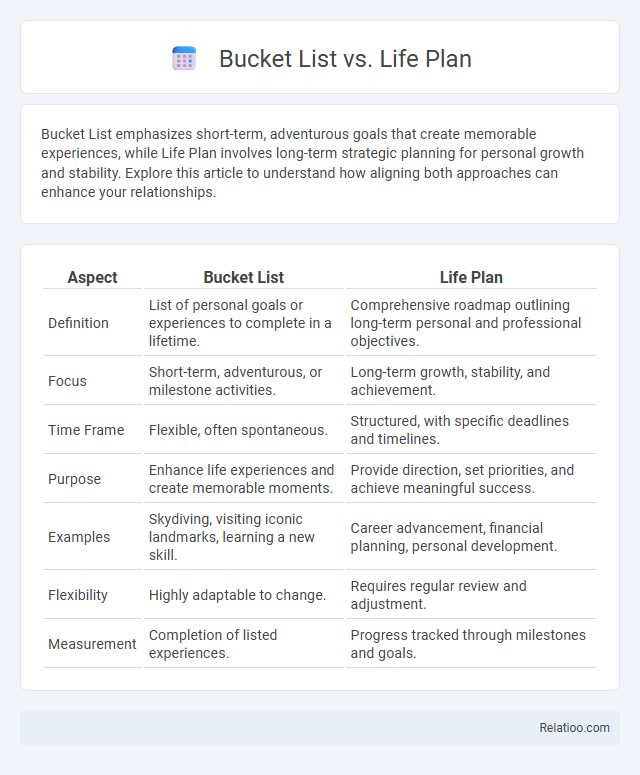Bucket List emphasizes short-term, adventurous goals that create memorable experiences, while Life Plan involves long-term strategic planning for personal growth and stability. Explore this article to understand how aligning both approaches can enhance your relationships.
Table of Comparison
| Aspect | Bucket List | Life Plan |
|---|---|---|
| Definition | List of personal goals or experiences to complete in a lifetime. | Comprehensive roadmap outlining long-term personal and professional objectives. |
| Focus | Short-term, adventurous, or milestone activities. | Long-term growth, stability, and achievement. |
| Time Frame | Flexible, often spontaneous. | Structured, with specific deadlines and timelines. |
| Purpose | Enhance life experiences and create memorable moments. | Provide direction, set priorities, and achieve meaningful success. |
| Examples | Skydiving, visiting iconic landmarks, learning a new skill. | Career advancement, financial planning, personal development. |
| Flexibility | Highly adaptable to change. | Requires regular review and adjustment. |
| Measurement | Completion of listed experiences. | Progress tracked through milestones and goals. |
Understanding the Concepts: Bucket List vs Life Plan
A bucket list consists of specific experiences or achievements an individual aims to accomplish before a certain time, often before death, emphasizing short-term or goal-oriented tasks. In contrast, a life plan serves as a comprehensive roadmap for personal and professional growth, encompassing ongoing goals, values, and milestones over an extended period. Understanding the distinction between a bucket list and a life plan highlights the difference between episodic aspirations and structured, long-term life strategy.
Key Differences Between a Bucket List and a Life Plan
A bucket list comprises specific experiences or goals a person aims to achieve, often adventurous or once-in-a-lifetime activities, while a life plan is a comprehensive roadmap outlining long-term personal, professional, and financial objectives. Key differences include the scope and time horizon: bucket lists focus on short to medium-term desires, emphasizing enjoyment and fulfillment, whereas life plans integrate goals related to career development, education, relationships, and retirement, providing structure and direction over decades. The motivational drivers also differ; bucket lists inspire spontaneity and exploration, while life plans promote stability, growth, and achievement through strategic planning.
The Purpose Behind Each Approach
A Bucket List emphasizes experiencing specific adventures or milestones, aiming to capture moments of joy and personal achievement before time runs out. A Life Plan centers on long-term goals and structured growth, providing a strategic roadmap to balance career, relationships, and personal development. Combining these approaches allows individuals to pursue meaningful experiences while maintaining clear direction and purposeful living.
Benefits of Creating a Bucket List
Creating a bucket list helps you clarify your personal goals and prioritize meaningful experiences, fostering motivation and a sense of purpose. Unlike a life plan, which outlines long-term strategies, a bucket list focuses on specific activities or achievements that bring joy and fulfillment. Your bucket list can serve as a powerful tool to inspire adventure, enhance personal growth, and create lasting memories.
Advantages of Having a Life Plan
Having a life plan provides a structured framework for setting long-term goals, promoting clarity and focused decision-making that aligns with personal values and aspirations. It enhances time management by prioritizing tasks effectively, ensuring consistent progress toward career, health, and relationship milestones. Unlike a bucket list, which lists ambitions often pursued sporadically, a life plan integrates goals into a cohesive strategy, increasing motivation and accountability for sustained success.
How to Start Building Your Bucket List
Begin building your bucket list by identifying personal goals and experiences that align with your passions and values. Use specific categories such as travel, skills, adventure, and personal growth to organize ideas clearly. Prioritize achievable milestones and create a timeline to track progress while allowing flexibility for new aspirations.
Steps to Developing a Personal Life Plan
Developing a personal life plan involves assessing core values, setting long-term and short-term goals, and creating actionable steps to achieve them. Unlike a bucket list that focuses on individual experiences to complete, a life plan integrates career, relationships, health, and personal growth into a structured roadmap. Prioritizing tasks, establishing timelines, and regularly reviewing progress ensure the life plan remains aligned with evolving ambitions and life circumstances.
Integrating a Bucket List Into Your Life Plan
Integrating a bucket list into your life plan creates a cohesive roadmap that balances long-term goals with meaningful experiences, enhancing personal fulfillment. This integration prioritizes actionable steps, blending dreams with practical timelines and resource management to maximize achievement. Combining a bucket list with a structured life plan ensures continuous motivation and measurable progress toward both aspirational and pragmatic objectives.
Common Mistakes to Avoid
Confusing a bucket list with a life plan often leads to unrealistic goal setting, as bucket lists emphasize short-term experiences while life plans require long-term strategic actions. Failing to prioritize or update these lists regularly results in stagnant goals and diminished motivation. Avoid treating bucket lists as detailed blueprints, instead integrate them into a flexible life plan to ensure balanced personal growth and achievement.
Choosing What Works Best for Your Dreams and Goals
Choosing between a Bucket List, Life Plan, and Goal List depends on how you envision achieving your dreams and staying motivated. A Bucket List captures exciting, often spontaneous experiences you want to accomplish, while a Life Plan provides a structured roadmap with long-term objectives and milestones. Your best strategy combines the inspiration of a Bucket List with the strategic focus of a Life Plan, ensuring your dreams are both imaginative and achievable.

Infographic: Bucket List vs Life Plan
 relatioo.com
relatioo.com